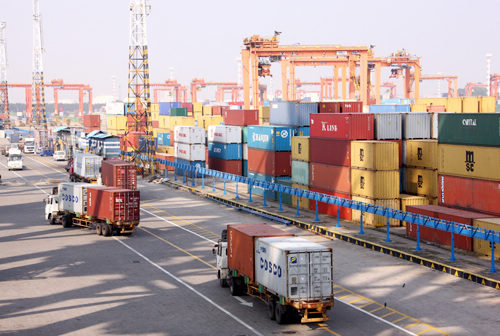|
 |
|
MORE BALANCED TRADE: Xiamen Haicang Bonded Area in Fujian Province. In the coming years China will implement a more balanced trade policy (GAO XUEYU) |
According to Yu, China has fulfilled its WTO commitments, adjusted tariff rates and non-tariff trading mechanisms, and opened service trade. Domestic laws and regulations, after amendments, all conform to China's WTO commitments and WTO rules.
"During this process, we have accelerated the market-oriented progress and established a trading system which is more stable and more transparent and open, and this has made the business environment more open and better regulated," Yu said. "Recognition of the non-discrimination principle, the transparency principle and the rule of fair competition of the WTO, as well as a market-oriented economy, the rule of law and the protection of intellectual property rights have reached unprecedented heights, which has exerted a far-reaching impact on the transformation of government functions and the renovation of public ideas."
The past decade has seen the best and most rapid development in China, and also the sharing of economic interests between China and other countries.
"In the past decade we imported an average of $750 billion worth of goods each year, creating more than 14 million jobs in other countries," he said.
During the past 10 years, China has participated in trade promotion and foreign aid around the world, with the latter effort covering such fields as infrastructure, public utilities, social welfare facilities, agriculture, health care and education. China's assistance has also helped the least developed countries enhance their capability to participate in global trade. China grants zero-tariff treatment to commodities produced by 41 of the least developed countries and has become the biggest export destination for them.
China's accession to the WTO has also promoted the development and improvement of its market-oriented economy.
"Under the planned economy, the national economy was managed by government documents, but now it is managed by laws and regulations, in an open and transparent way both at the central and local levels," Yu said.
During the WTO entry negotiations, China's biggest rival was the United States. But 10 years later, people find that Sino-U.S. economic ties have been closer than any other economic relations.
Before China's entry into the WTO, the U.S Congress held an annual vote on whether to grant China the most favored nation status. As a WTO member, this status is a right and has acted to promote trade between the two countries.
Figures from the Ministry of Commerce (MOFCOM) show that China-U.S. bilateral trade increased from $80.5 billion in 2001 to $385.34 billion in 2010. Today, China and the United States are the second biggest trading partners to each other. The United States is China's second largest export destination, while China is the third largest and the fastest growing export destination for the United States.
Sun Zhenyu, former Chinese ambassador to the WTO, said the United States and European countries are the biggest beneficiaries of China's WTO membership.
Sun said a multi-lateral trading mechanism was produced after World War II, and all prevailing world trade rules were formulated under the lead of the United States and developed European countries. It's no surprise that many clauses do protect the interests of these countries. Ever since applying for WTO membership, China has been reforming and adapting to these rules, though none of which was made with input from China.
According to Sun, the United States and Europe have benefited from the multi-lateral trading mechanism for dozens of years. Although China is now the second largest trading nation and the largest exporting nation in the world, most of its products are of low added value. China, for the time being, is just a workhorse producing consumer goods for the West.
Producing an iPhone, which sells for $299 in the United States, China earns trade surplus of $150, but Chinese companies receive less than $4 of the profits.
With the two countries strengthening cooperation and competition in the manufacturing sector, China is increasingly relying on imports of stable farm produce from the United States, like soybeans, corn and cotton.
According to statistics from the Ministry of Agriculture, China's total farm produce imports went up from $11.8 billion in 2001 to $71.9 billion in 2010, an average annual increase of 22.2 percent. China first faced agriculture trade deficits in 2001. Now, agriculture trade deficits have lasted eight years, and in 2010 the deficits stood at $23.04 billion, up 5.7 fold from 2004.
| 